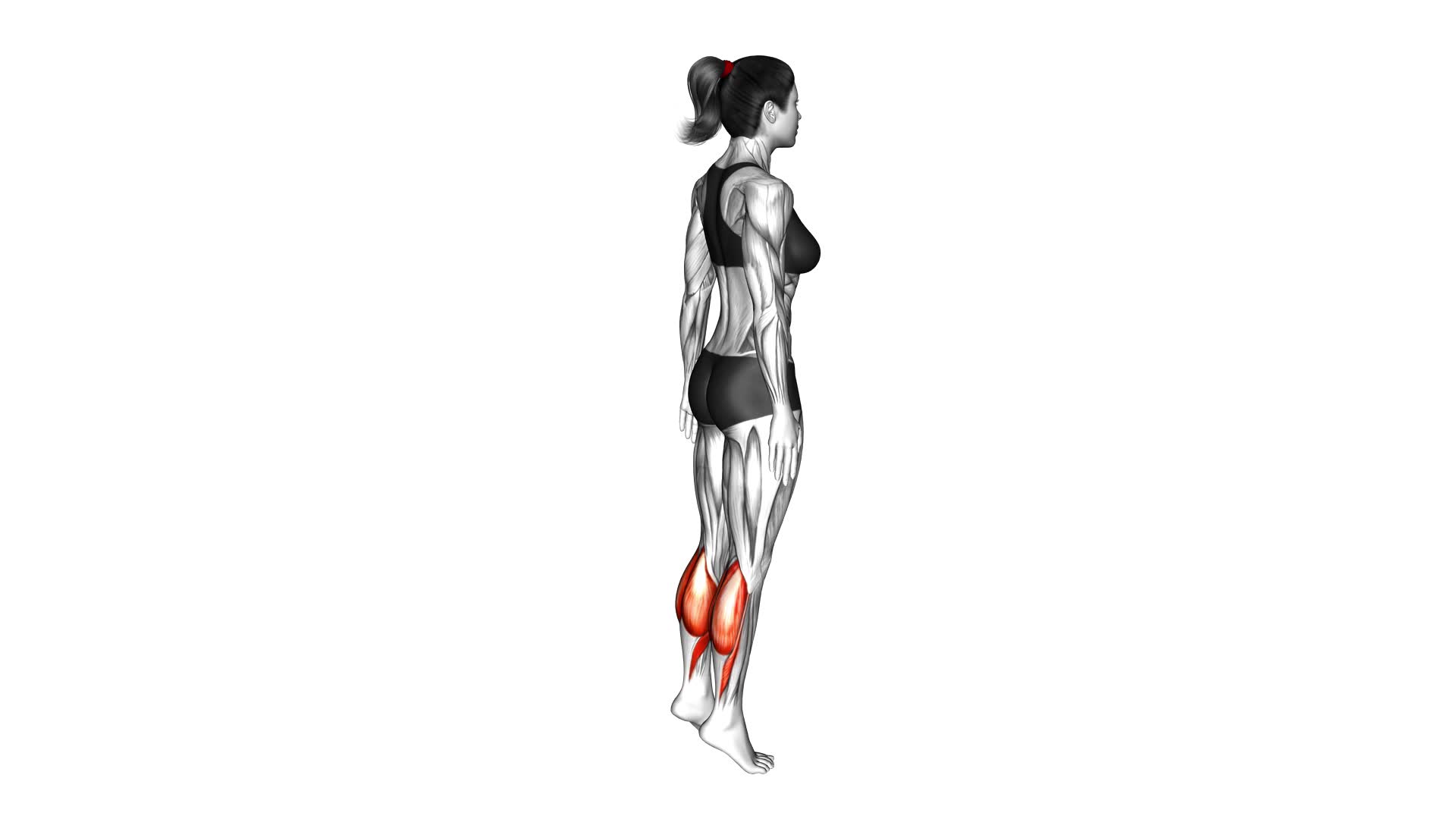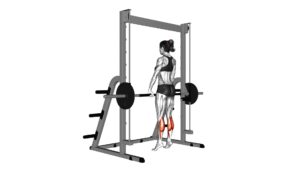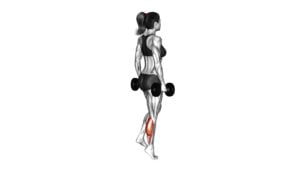Standing Calf Raise (female) – Video Exercise Guide & Tips

Want to strengthen and tone your calf muscles? Look no further than the standing calf raise! This exercise is specifically designed for females and targets the calves for a sculpted and defined look.
Watch This Exercise Video
In this video exercise guide, we'll show you the proper technique, variations, and modifications to make the most out of your calf raises. Avoid common mistakes and get expert tips on how to incorporate this exercise into your workout routine effectively.
Let's get those calves working!
Key Takeaways
- Standing calf raise targets and sculpts the calf muscles for a defined look.
- It helps to strengthen and tone the calf muscles while improving balance and stability.
- By increasing the size and definition of the gastrocnemius and soleus muscles, it gives the legs a more toned appearance.
- Variations and modifications can be incorporated to target different areas of the calf muscles and keep the workouts interesting.
Benefits of Standing Calf Raises for Females
Boost Your Strength and Stamina with Standing Calf Raises.
If you're looking to tone your calf muscles and improve your balance and stability, standing calf raises are the perfect exercise for you. This simple yet effective exercise targets the muscles in your calves, helping to strengthen and define them. By regularly incorporating standing calf raises into your workout routine, you can achieve stronger and more toned calves.
One of the main benefits of standing calf raises is calf muscle toning. This exercise specifically targets the gastrocnemius and soleus muscles in your calves, helping to increase their size and definition. As you rise up onto your toes, you engage these muscles, causing them to contract and become stronger over time. This can lead to more defined and sculpted calves, giving your legs a more toned appearance.
In addition to calf muscle toning, standing calf raises also contribute to improved balance and stability. As you perform this exercise, you must maintain a stable and upright position, relying on the strength of your calf muscles to support your body weight. This requires a strong core and good balance, helping to improve your overall stability.
To learn the proper technique for standing calf raises and maximize their benefits, continue reading the next section.
Proper Technique for Standing Calf Raises
To perform standing calf raises correctly, you should start by standing with your feet shoulder-width apart. Keep your back straight and engage your core muscles for stability. Begin the exercise by lifting your heels off the ground, rising onto the balls of your feet. Slowly lower your heels back down to the starting position. Repeat this motion for the desired number of repetitions.
It is important to maintain proper form throughout the exercise to maximize its benefits and avoid common errors. One common mistake is using momentum to lift the heels instead of relying on the calf muscles. This reduces the effectiveness of the exercise and increases the risk of injury. Another mistake isn't fully extending the ankles at the top of the movement. This limits the range of motion and reduces the engagement of the calf muscles.
While standing calf raises are often associated with females, they also offer numerous benefits for men. This exercise helps to strengthen the calf muscles, improve ankle stability, and enhance overall lower body strength. Strong calf muscles can also improve athletic performance, such as running, jumping, and agility movements.
Now that you know the proper technique and benefits of standing calf raises, let's explore variations and modifications that can add variety and challenge to your calf workout.
Variations and Modifications for Standing Calf Raises
If you want to add variety and challenge to your calf workout, consider trying different variations and modifications for standing calf raises. By incorporating these modifications, you can target different areas of your calf muscles and keep your workouts interesting.
One modification you can try is the single-leg standing calf raise. Instead of using both legs, you'll focus on one leg at a time. This variation increases the intensity and balance required for the exercise.
Another modification is the seated calf raise. Instead of standing, you'll be seated with your knees bent and your feet resting on a platform. This variation puts more emphasis on the soleus muscle, which is located deeper in the calf.
You can also experiment with different foot positions, such as toes pointed in, toes pointed out, or feet parallel. Each variation targets different parts of the calf muscles, providing a well-rounded workout.
Common Mistakes to Avoid During Standing Calf Raises
One common mistake to avoid during standing calf raises isn't fully extending your ankles at the top of the movement. Proper technique is crucial for maximizing the benefits of this exercise and preventing injury. When you perform a standing calf raise, make sure to rise up onto the balls of your feet as high as possible, lifting your heels off the ground. This full extension of the ankles ensures that your calf muscles are fully engaged and activated. Failing to do so can limit the effectiveness of the exercise and lead to imbalances in your lower leg muscles.
Another common mistake is using too much momentum to lift your body up. It's important to maintain control throughout the movement and not rely on swinging your body or using excessive force. Slow and controlled movements will target the calf muscles more effectively and reduce the risk of strain or injury.
Lastly, avoid arching your back or leaning forward during standing calf raises. This can shift the focus away from the calves and place unnecessary strain on your lower back. Instead, keep your core engaged and your spine neutral throughout the exercise.
By avoiding these common mistakes and focusing on proper technique, you can maximize the benefits of standing calf raises and achieve stronger, more defined calf muscles.
Now, let's move on to some tips for incorporating standing calf raises into your workout routine.
Tips for Incorporating Standing Calf Raises Into Your Workout Routine
To incorporate standing calf raises into your workout routine, focus on gradually increasing the weight or resistance used for this exercise. Proper form is essential to maximize the effectiveness of the exercise and prevent injury.
Start by standing with your feet shoulder-width apart, toes pointing forward. Keep your core engaged and maintain a straight posture throughout the exercise. Slowly rise up onto the balls of your feet, lifting your heels off the ground as high as possible. Hold the contraction for a moment before slowly lowering your heels back down to the starting position. Aim for a controlled and smooth movement throughout the exercise.
When it comes to sets and reps, it's recommended to start with 2-3 sets of 10-12 repetitions. As you progress, you can increase the number of sets or reps to challenge your calf muscles further. Additionally, you can also increase the weight or resistance by using dumbbells, a barbell, or a calf raise machine.
Gradually increase the weight or resistance as your strength improves, but always prioritize proper form over the amount of weight used. Remember to listen to your body and adjust the weight and intensity of the exercise accordingly.
Frequently Asked Questions
Can Standing Calf Raises Help in Reducing Cellulite or Toning the Back of the Legs?
Standing calf raises can be effective for reducing cellulite and toning the back of your legs. By engaging the calf muscles, this exercise helps to strengthen and tone the lower leg area. As you perform the standing calf raise, your muscles contract, promoting blood circulation and the breakdown of cellulite.
Additionally, the exercise targets the gastrocnemius and soleus muscles, which can contribute to a more defined and toned appearance in the legs.
Is It Necessary to Use Weights or Can Standing Calf Raises Be Done Without Any Additional Resistance?
No, it isn't necessary to use weights for standing calf raises. You can do this exercise without any additional resistance. However, using weights can add more challenge and intensity to your workout.
If you prefer not to use weights, there are alternative exercises you can try to target the calf muscles such as seated calf raises or calf raises on a leg press machine.
Remember to always listen to your body and choose the option that works best for you.
How Often Should Standing Calf Raises Be Performed to See Noticeable Results?
To see noticeable results from standing calf raises, you need to perform them regularly. The frequency at which you should do them depends on your fitness level and goals.
Generally, it's recommended to do standing calf raises two to three times a week. This frequency allows for proper muscle recovery and growth.
Additionally, incorporating different variations of standing calf raises, such as using weights or changing the foot position, can help target different areas of the calf muscles for better overall development.
Are There Any Specific Shoes or Footwear Recommended for Performing Standing Calf Raises?
When performing standing calf raises, it's important to wear recommended footwear for optimal results. The right shoes can provide proper support and stability, reducing the risk of injury.
Additionally, wearing shoes with a firm sole can help you maintain proper form and engage the calf muscles effectively.
Can Standing Calf Raises Help Improve Balance and Stability in Addition to Strengthening the Calves?
Yes, standing calf raises can definitely help improve your balance and stability, in addition to strengthening your calves. By performing this exercise, you engage the muscles in your lower legs, which can enhance ankle flexibility and stability.
Furthermore, there are variations of standing calf raises that you can incorporate into your routine to challenge yourself and further improve your balance and stability.
Conclusion
Incorporating standing calf raises into your workout routine can greatly benefit females by strengthening and toning their calf muscles. By following the proper technique and avoiding common mistakes, you can maximize the effectiveness of this exercise.
Additionally, there are variations and modifications available to cater to different fitness levels and goals. So, whether you're looking to enhance your athletic performance or simply improve your leg strength, standing calf raises are a valuable addition to any female's fitness regimen.

Author
Years ago, the spark of my life’s passion ignited in my mind the moment I stepped into the local gym for the first time. The inaugural bead of perspiration, the initial endeavor, the very first surge of endorphins, and a sense of pride that washed over me post-workout marked the beginning of my deep-seated interest in strength sports, fitness, and sports nutrition. This very curiosity blossomed rapidly into a profound fascination, propelling me to earn a Master’s degree in Physical Education from the Academy of Physical Education in Krakow, followed by a Sports Manager diploma from the Jagiellonian University. My journey of growth led me to gain more specialized qualifications, such as being a certified personal trainer with a focus on sports dietetics, a lifeguard, and an instructor for wellness and corrective gymnastics. Theoretical knowledge paired seamlessly with practical experience, reinforcing my belief that the transformation of individuals under my guidance was also a reflection of my personal growth. This belief holds true even today. Each day, I strive to push the boundaries and explore new realms. These realms gently elevate me to greater heights. The unique combination of passion for my field and the continuous quest for growth fuels my drive to break new ground.



